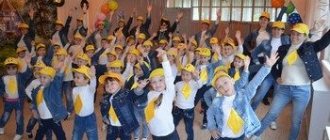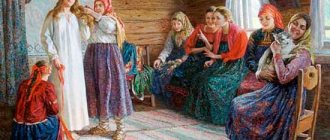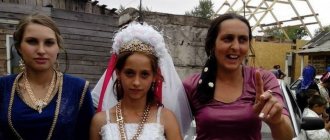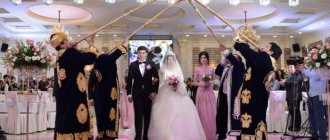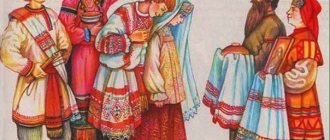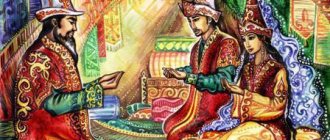Dagestan is home to a large number of small peoples, who are distinguished by their unique characteristics in the field of culture, language, and interpersonal relationships. Every nation takes great interest in the traditions and customs of their ancestors and tries to learn all their subtleties. This is necessary for a deeper understanding of the general Dagestan culture.
Everyone in this nation treats with particular trepidation the formation of their own worldview, which has been based on the customs of Dagestan since childhood. The older generation is very serious about preserving and transmitting all the subtleties of the traditions of Dagestan, as well as ensuring that their essence is not distorted, but transmitted in its true sense. Each of them is a unique reflection of the mentality of the people, their worldview and national spirit.
Dagestan
The family traditions of Dagestan are especially interesting for studying other nations. In general, family for this people is a sacred concept, which is based not only on blood kinship, but also on spiritual unity. Representatives of each nation, even if they are not blood relatives, are still considered brothers and sisters, bearers of a single cultural and ethnic spirit.
Geography of the region
Dagestan is the southernmost and most mountainous republic of the Russian Federation. The Caucasus ranges occupy the bulk of its territory, and it is here that Bazarduzo, the highest mountain in Russia, is located. The peoples living in Dagestan are real mountaineers. A small part of the lowland is located only in the northern part of the foothills. The east of Dagestan is washed by the waters of the Caspian Sea. On the territory of the republic there are about 6 thousand large, small and very small rivers and rivulets, of which 100 are classified as large rivers (only 20 of them reach the Caspian Sea). The most famous: Terek, Samur, Sulak.
The climate in general is warm-temperate; fluctuations in temperature and precipitation depend on the altitude, distance from the sea, and surrounding mountain ranges. Land areas are divided into flat, foothill and mountainous. Their geography determines the main occupation of local residents.
Laktsy
The central part of Nagorno-Dagestan is inhabited by another people - the Laks. Language – Lak, religion – Islam. This people have lived on the territory of Dagestan since ancient times. Their main occupation is growing wheat crops (rye, wheat, millet, legumes, barley, etc.). Livestock farming was also developed. Among the crafts, cloth making, jewelry making, pottery, stone processing, silver and gold embroidery were developed. The Laks were famous traders, confectioners and acrobats. This people is rich and epic. Stories about the great heroes of the past and how they fought evil were passed down from mouth to mouth.
History of the region
The people of Dagestan have gone through such a difficult, eventful path in their historical development that complete descriptions of it are not articles, but entire volumes. Some nationalities of the republic are related to the Medes, Hittites, and peoples of ancient Sumer. The first state that included the territory of southern Dagestan was Caucasian Albania, formed in the 5th century BC. Constant wars led to the fact that lands were transferred from one state to another, rulers and religions changed. The gradual process of the formation of Dagestan as a union of various nationalities was due to the need to unite small tribes to protect their lands from stronger enemies. Historically, the best lowland lands were occupied by newcomer peoples: Arabs, Shiites, Sunnis. The original local tribes were forced into the mountains, but over time they all became close and founded their own single Dagestan epic.
Wedding events
After the engagement, preparations begin for the celebrations. This is mainly done by parents. And the bride must arrange a house or apartment where the young family will live. The groom's side purchases the property. If, due to the financial situation of the newlyweds, it is planned to settle in the house of the groom’s parents, then the girl will decorate the allocated wing or rooms. In addition to the dowry for their daughter, parents purchase household appliances and furniture.
Celebration at the bride's house
Previously, under her stepfather's roof, a small farewell feast was organized for the girl to be married off. Nowadays, a full-fledged wedding is celebrated, which, however, has its own unique characteristics. Musicians are located on the roof of the house. From the very morning they begin to perform ritual songs reminiscent of anguished crying. At this time, the girl, amid the lamentations of her surrounding girlfriends, is preparing to leave her parents' house. She sings farewell songs and dresses in wedding attire.
By noon, a procession consisting exclusively of women leaves the groom's house. They carry treats, sweets, jewelry and hand-woven carpets. The groom and other men follow at a distance, singing traditional ritual songs. When guests enter the house, everything brought is put into a chest, which will then be sent with the young wife to a new place of residence. After this, the feast begins.
A girl's entry into married life
In old times, it was on this day or the day before that the wedding ceremony was held in the Islamic tradition. The groom himself, the mullah and the bride's representative, father or senior relative were present.
Nowadays, on the first day of celebrations, the girl’s mother and other relatives, crying and wailing, hand the newlywed over to a new family. However, this transfer is purely symbolic: the bride stays overnight in her father’s house.
Celebration at the groom's house
In the morning on the appointed day, the groom comes for his betrothed and takes her under his arm, into his home. The celebration itself begins after noon. It is on this day that competitions are held, young people boast to each other about their strength and dexterity, competitions and funny pranks are held. Dancing and congratulations follow one after another. At the same time, joint dancing is very rare - men have fun separately from women.
Interesting wedding customs of Dagestanis
The thousand-year-old culture of the Dagestan people is rich in traditions, signs and beliefs associated with weddings.
- The designated wedding celebrations should not coincide with major Muslim holidays or fasting days, or the birthdays of the couple and their parents.
- The mother of the young wife brings diluted honey to the newlyweds so that life is sweet and hassle-free.
- On the threshold of the girl's house, the groom is met by his betrothed's sister and performs a ritual dance.
- Before the newlyweds dance together, the bride must dance with every man present among the guests. He should not touch her, only describe circles and throw coins at her feet.
A special master of ceremonies keeps order at the wedding; he also conducts competitions, says toasts and monitors the performance of rituals.
Wedding feast and toasts
The law of hospitality says: no guest should leave hungry. And greetings and well wishes to the young are heard almost continuously. At the same time, the number of toasts does not at all mean a command to get drunk. On the contrary, excessive consumption of alcohol is severely condemned.
A toast is a rather long parable, the wisdom of our ancestors is often passed down from generation to generation. An experienced toastmaster remembers many such beautiful stories, designed to teach young people about life, to wish well-being and good relationships. Congratulations are also addressed to parents and friends, as well as everyone present. Any wedding guest can raise a glass and say a toast. The main condition is to observe the order and not shout down the speaker.
Songs, dances and entertainment
Of course, where would we be without the traditional Lezginka? A most beautiful dance, during which a young man shows his dexterity, prowess and strength, and a woman must demonstrate modesty and the ability to emphasize the dignity of her partner, and all this action is performed in chic traditional outfits! There is something to look at and show yourself from the most advantageous side. This dance combines the indomitable spirit of Dagestan men and the gentle flexibility of women. Everyone can and loves to dance it, from kids to gray-haired elders.
The dance events are opened by the designated main dancer, after which all interested men can join him. The order is determined by the transfer of flowers: as soon as one dancer gets tired, he passes the bouquet to another, and the applicant chosen from among the guests should not refuse one or two circles. Dancing for the female half of the guests is marked by an invitation to the groom's sister to dance. Only after her can the rest of the ladies enter the circle.
Dancing and singing at a Dagestan wedding are the main entertainment. They last from the beginning to the end of the festival. These include traditional national dances, ritual melodies, and modern popular compositions, and karaoke.
Some statistics
What do meager figures tell about Dagestan:
- The territory of the republic is 50.3 thousand km2.
- The coastline is 530 km, the total land borders are 1181 km.
- The highest point is 4466 km, the average altitude above sea level is 1000 km.
- The total population, according to the latest census, is 2125 thousand people.
- The number of peoples of Dagestan is 102, of which 30 are indigenous.
- The territorial division of the republic is 22 districts.
- The population of rural areas is 69%.
- Heroes of the Soviet Union (Dagestanians) - 49 people.
Peoples of Dagestan
The list of main nationalities looks like this:
- Avars - 30% of the total population, mainly occupy the mountainous regions of western Dagestan.
- Dargins - 17% of the ethnic group, traditionally settled in the mountains and foothills of the central part of the republic.
- Nogai - 16% of the population, main residence - Nogai steppe in northern Dagestan.
- Kumyks - 13% of the population, which occupies the Turkic-Sulam lowland and the northern foothills.
- Lezgins - 12%, places of settlement - mountains, foothills and plains of Southern Dagestan.
- The Russian population of Dagestan, also classified as local, occupies 7% of the population. Most Russians live in the capital Makhachkala and other cities and towns. Urban dwellers among Russians make up 80%. Representatives of Russian rural residents are mainly Terek Cossacks, whose settlements are concentrated in the lower reaches of the Terek.
- Laks are concentrated in the central part of the mountains and account for 5% of the ethnic composition.
Approximately 4% each of the total number consists of such nationalities as Tabasarans, Turks (Azerbaijanis), and Chechens. The number of the latter increased sharply after the start of hostilities on the territory of the Chechen Republic. Tats (the people of Dagestan, who call themselves Dagestan Jews), Rutuls, Aguls, Tsakhurs, living mainly in certain individual territories, make up a small part of the Dagestan population.
In addition to indigenous groups, Uzbeks, Kazakhs, Ukrainians, Georgians, Tatars, Belarusians, Ossetians, and Persians who have lived here since birth consider themselves residents of Dagestan.
Kubachi residents
These people of Dagestan live in the small village of Kubachi, Dakhadaevsky district. Their number does not exceed 1900 people. In addition, Kubachi residents also live in other settlements in Central Asia and the Caucasus. Their native language is Kubachi. The inhabitants of this settlement are mainly artisans. If they grew food or grazed livestock, it was of an auxiliary nature.
The most common crafts have long been metalworking, construction, wood and stone carving. Women were engaged in knitting, weaving, embroidery, and made felt from which they made shoes. Knowledge and skill in metal processing was passed on from father to son. Interesting are the folk dances of the Kubachi people, which were carefully developed for the performance of various rituals.
Language composition
Indeed, such a diversity of nationalities and nationalities on a relatively small piece of land is not found anywhere else in the world. Corresponding is the diversity of the linguistic composition. There are 30 indigenous languages in Dagestan alone. This is also what makes Dagestan unique. What other people can present to the world such a difference in languages, dialects and dialects with, in general, a unified culture, customs, and everyday traditions.
Linguists, together with historians, have identified the significant isolation of villages from each other, associated with the geographical and climatic conditions of the mountainous area, as the main reason for the complex linguistic differences. The emergence of individual dialects was also facilitated by different religious preferences, political and social disagreements, and isolation within individual clans.
According to the linguistic composition, the population of Dagestan is divided into three main groups:
- North Caucasian family, Nakh-Dagestan branch (Avars, Dargins, Lezgins, Laks, Tabarasans, Rutuls, Aguls, Tsakhurs, Chechens).
- Altai language family, Turkic group (Turks, Kumyks, Tatars, Nogais).
- Indo-European language family (Russians, Ukrainians, Belarusians, Tats, Jews, Armenians).
Kunachestvo
It is customary to call a kunak a close friend or closest comrade among those present, but invariably connected with the owner of the house by close ties of long-standing friendship and shared events. Kunakism is a relatively late phenomenon, originating in the traditions of hospitality and the gradual weakening of blood and family ties in the realities of the modern world. If earlier residents of the settlement sometimes spent their entire lives in it, not counting the girl’s move to the groom’s house after marriage, now many Dagestanis leave their parents’ places for study, work, career or for other reasons.
The institution of kunakism became so firmly established in the life of the people that kunaks began to be passed down, as it were, by inheritance - from father or grandfather to son or grandson, from one descendant to another. Sometimes they were connected by newly acquired family ties, often the children of friends began to be friends, etc. However, it has always been considered correct to have Kunaks as close as possible in nationality or from other Caucasian peoples with whom the Dagestanis have developed good neighborly relations.
Religious denominations
In terms of religious beliefs, the modern people of Dagestan are mostly (90%) Sunni Muslims. But it was not always so. Back in the first century AD, the population of Caucasian Albania, and then all Dagestanis, adopted Christianity; Islam was imposed on the Albanians as a result of the hundred-year war with the Arabs. But over many millennia, it was Islam that established itself not only in Dagestan, but also spread to other territories of the Caucasus. Another branch of Muslims are the Shiites, these are mainly Turks, to whom some Lezgin settlements have also joined. Judaism is professed by mountain Jews - Tats, while the Orthodox population, including adherents of the Armenian-Gregorian Church, makes up 9%. There is no acute hostility towards people of other faiths; the mixture of languages and religions fosters tolerance towards the religions of neighbors.
Hospitality is the most important folk custom
The most revered tradition of the Dagestan peoples is, of course, hospitality. There are many poems and songs about this. The customs of kunakism are intertwined with hospitality, since the first often turned into the second. A Dagestan house is always full of guests. Whether you find yourself in a village of Dargins or Avars, you will be welcomed, despite the fact that they are seeing you for the first time in their lives. Whatever the guest, he is received with honors, as if he had been long-awaited.
The folk traditions of Dagestan dictate that even a stranger should be received with honor if he finds himself in the courtyard of a house. There are still certain rules regarding how to receive guests. The hosts are obliged to be attentive and benevolent towards the guest and to fulfill his wishes.
So, in the old days the Avars had an interesting custom. If a guest familiar to a particular family came to the village, there were no problems with the reception - he himself drove up to the house and found himself in the welcoming atmosphere created by the owners. If a stranger appeared in the village, he could come to the godekan, where the elders decided to whom to send the guest home.
More often than not, those interested found themselves. But if none of the residents volunteered to show hospitality, the village elder himself “appointed” the host. It never occurred to anyone to argue with his decision. The appointed owner took the stranger and gave him all due honors.
In many Dagestani houses there is still a custom - a portion is always left at the table so that you can treat an unexpected guest. Isn’t this the height of hospitality and care for those who are now on the move? Even if the family was poor, it was considered a matter of honor to provide the guest with a cozy and comfortable environment, take care of his safety, and provide tasty food.
It often happened that an unexpected guest, remembering the kindness and friendliness of the owner, subsequently became a real kunak and began to be considered a kind of “family friend.” Even if the father of the family had already died, such a guest, according to the traditions of Dagestan, remains a kunak for the whole family and can come come here at any time, as if you were visiting family.
Kunakism, which became a consequence of hospitality (but not necessarily only it), gave rise to its own traditions. Among many Dagestani peoples, a kunak became the named father of his friend’s children, a kind of second parent or uncle. He could replace the father or mother of deceased children, looked after them and helped run the household until they gained complete independence.
A special point in national traditions was the responsibilities of the host if his guest is in danger. He was obliged not only to shelter the stranger in his house or hide him, but also to take up arms to protect the guest. Most of all these ancient customs are preserved in Dagestan villages today, invisibly connecting the spirituality of distant ancestors with the issues of educating their current descendants.
Big nations and small nations
Frequently asked questions about any multinational country or republic: “Which people are the main and most numerous? Whose traditions and language predominate in the region?” In this case, it is difficult to answer them, for the reason that the peoples of Dagestan, the list of which is compiled in order of decreasing percentage of the total number, includes several more ethnic groups, which give the total percentage of the nationality.
Avars, who make up a third of the republic's population, are the common name for fifteen ethnic groups. The Andians, Archins, Akhvakhs, Bagulals, Bezhta, Botlikhs, Ginukhs, Godoberins, Gunzibs, Didois, Tindins, Karatins, Khvarshins, Tsez, Chamaltas consider themselves to be Avars. 17% of Dargins are Kubachi and Kaitag people. This is the Caucasian Babylon and Jerusalem.
The Tsakhurs are considered the smallest people in Dagestan; their number on the territory of the republic is about 10 thousand people. Most Tsakhurs live in Azerbaijan. This nation in Dagestan has settled in the most inaccessible highland region - Rutulsky, the source of the Samur River. The village of Tsakhur is considered the most ancient village of Dagestan, its history goes back to the distant historical past, and the name translates as “Burning village”. Numerous hordes of conquerors repeatedly burned it to the ground, but the patient people restored the village again and again.
Customs and traditions
In countries where Islam is the leading religion, the entire life of society is subject to Sharia law, which in most cases is enshrined in law. Caucasians, which include the people of Dagestan, refer to the customs and traditions that regulate almost all aspects of social life as “adat”. The way of family life, relationships with neighbors, rules of matchmaking and marriage, hospitality - everything is taken into account in the set of unwritten rules of the highlanders, intertwined with some dogmas of religion, but does not always correspond to legal norms. If the rules of receiving guests and honoring elders deserve respect and praise, then the adat of blood feud already runs counter to state laws. Many traditions in modern Dagestan are gradually losing their relevance, but the laws of the ancestors are still strong in the local society.
Visiting the hunter
Once upon a time, hunting in these places was a necessity, a means of survival, but today it is more of a hobby. Almost everyone keeps livestock, even in the poorest and most remote villages, and it is quite enough to feed a family. As one of my interlocutors, whom I met back in Makhachkala, who was fond of hunting in the past, admitted, now sometimes you don’t even know how to talk about it - you meet so much condemnation. And before, hunters were respected - they went after bears, of which there are many in these places today, and they shot wolves.
However, even now you can still meet hereditary hunters who have an excellent knowledge of the forest and their craft, who live by hunting. We were lucky enough to meet one of these people. And not just meet, but come for a visit, get acquainted and chat.
Photo: Alexey Terentyev
“Just yesterday I left the house in the morning, I saw a wolf standing on the mountain, they often come here to us, they can steal livestock.” I almost always shoot wolves,” says Abdujalil, standing on the road leading to his house. — In general, we don’t eat wolves, but there are certain villages in which wolf meat is valued very highly and is considered healing. We sometimes take it there, where you can get good money for meat.
His small house perched lonely on the slope of the gorge. Below is a mountain stream. On both sides there are mountains and a forest - the kingdom of Abduzhalil, in which, it seems, he knows, hears and feels every sound, every rustle, every twig. Any nearest village is many hours' walk away. And although a road runs through the gorge not far from the house, even cars don’t drive here very often.
His house is clean and tidy. There is wallpaper on the walls, a large table, upholstered furniture - this is how many people live now, even in the most remote villages. The wife comes out of the kitchen, and her face lights up with a smile. You can see how happy she is with the guests. The table is immediately set, and the hostess prepares fresh khinkal, takes out salted lamb tail, wine and other supplies. My wife's name is Nina, she herself is from Tver. It is extremely pleasant to meet a compatriot here, far in the mountains. In response to our questions, after finishing lunch, Nina and Abdujalil agree to tell their story.
Abdujalil, like most of the guys in these places, was engaged almost from childhood, in absentia. He didn’t really know his future wife, he only knew that he had a fiancée. And when I was very young, in Moscow - many Caucasians go to study and work in central Russia - I met Nina. Met and fell in love. For life. The hardest thing back then was telling my loved ones about my decision.
Photo: Alexey Terentyev
First, Abdujalil explained himself to his first bride. He called her to a meeting and talked to her personally. Since there was no love between the young people, and in these places it is customary to take a man’s decision for granted, no problems arose here. But telling loved ones about this turned out to be more difficult. He only dared to say that he would not marry the appointed bride over the phone while in Tver.
And how to say about Nina - I thought for a long time and finally decided: when one of his brothers came to Moscow, he introduced him to a girl, but did not say a word about marriage. Only at the station, when the train with his brother leaving for home began to pick up speed, he shouted that Nina was his bride. That's how they found out about it at home.
The young people were lucky - Abdujalil’s family accepted his choice and welcomed Nina as their own. They got married here and stayed to live. What can a hunter do without his mountains and forests? The couple carried the warmth and love throughout their lives. We say goodbye standing next to the house. Abdujalil and Nina hug, laugh, not afraid to show their feelings. There is tenderness in the eyes, joy from meeting guests and a small but obvious sadness. Maybe it’s the isolated life away from people and loved ones, or maybe the lack of children—after all, the latter is especially valued in the Caucasus.
